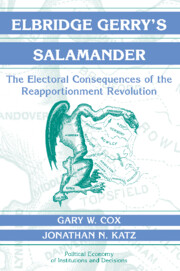Book contents
- Frontmatter
- Contents
- List of Tables and Figures
- Preface
- Part I Introduction
- Part II Democrats and Republicans
- 3 A Model of Congressional Redistricting in the United States
- 4 The Case of the Disappearing Bias
- 5 The Role of the Courts in the 1960s Redistricting Process
- 6 Bias, Responsiveness, and the Courts
- 7 Redistricting's Differing Impact on Democratic and Republican Incumbents
- Part III Incumbents and Challengers
- Part IV Conclusion
- References
- Author Index
- Subject Index
- Titles in the series
3 - A Model of Congressional Redistricting in the United States
Published online by Cambridge University Press: 10 November 2009
- Frontmatter
- Contents
- List of Tables and Figures
- Preface
- Part I Introduction
- Part II Democrats and Republicans
- 3 A Model of Congressional Redistricting in the United States
- 4 The Case of the Disappearing Bias
- 5 The Role of the Courts in the 1960s Redistricting Process
- 6 Bias, Responsiveness, and the Courts
- 7 Redistricting's Differing Impact on Democratic and Republican Incumbents
- Part III Incumbents and Challengers
- Part IV Conclusion
- References
- Author Index
- Subject Index
- Titles in the series
Summary
In this chapter, we develop a general model of the redistricting process in the United States. We use this model to examine two features of how congressional votes translate into seats: partisan bias (how much larger or smaller a party's seat share is than its vote share would warrant) and responsiveness (how much party seat shares respond to changes in vote shares). Bias and responsiveness are standard concepts in the analysis of redistricting and will be defined more fully later. From our model, we derive specific hypotheses about how the bias and responsiveness of a redistricting plan will differ as a function of two conditions obtaining when that plan is enacted: (1) the legally defined reversionary outcome of the redistricting process and (2) which party controls the legislative branches (house, senate, and governorship) of the state. We test our hypotheses in the next chapter.
a model of congressional redistricting
The literature on redistricting categorizes gerrymanders according to the varying goals that those who redraw district lines pursue. For present purposes, the most important categories are proincumbent gerrymanders (when a bipartisan alliance draws the lines to preserve the current incumbents' chances of victory) and partisan gerrymanders (when a single party draws the lines to maximize its seat share). In this section, we develop a model in which these two types of gerrymander – along with a third “mixed” type – emerge endogenously as a function of partisan control of the redistricting process and the nature of the reversionary outcome.
The basic elements of our model are straightforward. There are two parties, the Republicans and the Democrats, in a given state.
- Type
- Chapter
- Information
- Elbridge Gerry's SalamanderThe Electoral Consequences of the Reapportionment Revolution, pp. 31 - 50Publisher: Cambridge University PressPrint publication year: 2002

